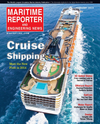
Page 36: of Maritime Reporter Magazine (February 2014)
Cruise Shipping Edition
Read this page in Pdf, Flash or Html5 edition of February 2014 Maritime Reporter Magazine
36 Maritime Reporter & Engineering News • FEBRUARY 2014
MR’S 75TH ANNIVERSARY row beam and was confi gured to have less resistance from the water at top speed, Anderson adds, noting “It left vir- tually no wake.”
The United States sped across the At- lantic on its maiden voyage on four 18-ft, manganese-bronze propellers - two out- board four-bladed propellers and two in- board fi ve-bladed propellers – said to be the fi rst used of mixed blades, designed by Elaine Kaplan of Gibbs & Cox. The propellers did their job on the record- breaking trip, says Hadler, but when the ship came back into port, they had severe propeller damage. “One was so badly eroded, at the root you could see through 8 or 9 inches.” As a result, the propellers ended up being designed three times to address two problems: cavitation, ero- sion and vibration. More blades can de- liver more power, but fewer blades are more effi cient and create less turbulence. “It’s something we in later years, by the late ‘60’s, got a handle on,” Hadler says.
Taking off the weight
More easily solved was the weight is- sue. And the primary answer to that was an almost obsessive use of aluminum through the ship, both for its super struc- ture and in its fi ttings, furnishings and décor.
While shipbuilders began using alumi- num more during WWII – because it was lighter than but as strong as steel – its use was limited because it can’t be welded, it weakens when heated and it doesn’t mate well with steel. Gibbs was not dissuaded.
He not only built his entire superstruc- ture from aluminum – extremely unusual at the time – to make the ship as light as possible, but he used it everywhere pos- sible, driving his decorators crazy while consuming 2,000 tons of the stuff. It was the largest amount used in any project in the world until the Twin Towers were built in the early ‘70s, according to his granddaughter, Susan Gibbs, executive director of the Conservancy. Gibbs and his team fi gured out how to outsmart the corrosive effect the two metals had on each other. “When steel and aluminum met, they didn’t like each other, so they had to put a layer between the two – neo- prene,” says Norris. Frozen rivets got around the welding and heat issues.
Coverage of the SS United States was voluminous, including the pages of the MR July 1, 1952 edition, in the years leading up to and including its maiden voyage. (Photo Cour tesy of Nor thr op Grumman Shipbuilding, Newpor t News , VA )
SS United States launching at New- port News Shipbuilding, (now Northrop
Grumman Newport News,) June 23, 1951.
MR #2 (32-41).indd 36 2/3/2014 10:25:13 AM

 35
35

 37
37
